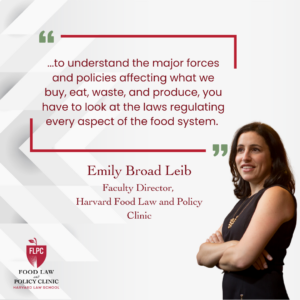Written by Minnie Che, FLPC research assistant
In May 2020, the Harvard Law School Food Law and Policy Clinic (FLPC) published a report on what we hoped to see in the next COVID-19 relief package to support the food system and consumers. COVID-19 has had a devastating impact on the food system in many ways, including increasing food insecurity for millions, decreasing demand in the restaurant and hospitality sector, leaving many food producers and distributors in a lurch, and causing staggering rates of COVID among food system workers in the food industry, leaving many of them without jobs or adequate paid leave.
On December 20, 2020 Congress came to an agreement about what the new COVID stimulus package will include – and what it won’t. President Trump signed the bill into law on December 27, 2020 after pressure from Republican lawmakers, though he has insisted on sending Congress a red-lined version of the bill with proposed budget cuts. The stimulus was included in a bill along with the 2021 appropriations act. The bill includes many new and continued funding opportunities related to nutrition assistance, food and agriculture, food donations, food businesses, and workers, though there were some big disappointments from the sector as well. This blog post breaks down the stimulus’ provisions that affect the food system and analyzes how they measure up to FLPC’s recommendations from the summer.
Unemployment benefits and direct payments
Millions of Americans have fallen into poverty as a result of the pandemic. Some of the hardest hit have been servers, cooks, and other workers in the food and hospitality industry. The $900 billion stimulus will provide supplemental unemployment benefit at $300 per week for up to 11 weeks. Americans who make under $75,000 will also receive an additional $600 stimulus check. While the House voted to increase the stimulus payments to $2000 after passage, this was blocked in the Senate.
SNAP and WIC
One of FLPC’s recommendation was an increase in the Supplemental Nutrition Assistance Program. In the new bill, $13 billion in increased benefits has been allotted to SNAP and other child nutrition benefits. SNAP benefits will see a 15% boost for six months starting Jan. 1, 2021, and will exclude unemployment compensation from being counted as income for eligibility purposes. This translates to a $25 increase in benefits per person per month. According to Share Our Strength, $25 dollars can buy a dozen eggs, a gallon of milk, an 8-pack of yogurts, a package of sliced cheese, a bag of baby carrots, a pint of blueberries, a jar of tomato sauce, a jar of peanut butter and a pound of dried spaghetti.
Eligibility for college students has also been expanded by waiving requirements that apply only to students and aligning them with standards for impacted workers with reduced work hours due to the pandemic. The bill will fund SNAP state administrative expenses as well as provide nutrition grants to the Commonwealth of the Northern Mariana Islands, Puerto Rico, and American Samoa. Seniors will see a $175 million increase in funding for Older Americans Act nutrition programs such as Meals on Wheels. The Commodity Supplemental Food Program, which serves more than 700,000 elder Americans monthly, will be provided $13 million. Participants of the Food Distribution Program on Indian Reservations (FDPIR), a tribal nutrition program, will also be allotted $7 million. And $75 million will be included through additional funding to the Gus Schumacher Nutrition Incentive Program to incentivize purchases of fruits and vegetables by SNAP participants.
In addition to direct payments, the stimulus also grants USDA $5 million for technical support in their expansion of SNAP online purchasing, in order to provide technical assistance to SNAP vendors in becoming eligible for online sales, and to support farmers markets and direct-marketing farmers with technology to support online EBT sales. This is line with FLPC’s recommendation to expand SNAP online purchasing and ensure more vendors would be approved for online SNAP sales (something that was also included in the Expanding Snap Options Act, which FLPC actively supported). Walmart and Amazon were the first vendors approved for online SNAP purchases, and in many states those were the only vendors approved for many months. Recently, Instacart and ALDI were added as SNAP partners in 23 states and D.C. With this new funding, USDA can continue to support eligibility of other vendors.
Food donations
In its report, FLPC proposed expanding tax benefits to incentivize donations and prevent food waste as the food industry experiences decreasing demand in perishable foods. In March, the CARES Act established a “universal charitable deduction” that allows taxpayers, on top of the standard deduction, a deduction for charitable contributions up to $300. The new bill extends this deduction through 2021. The bill also authorizes $1.5 billion for the Department of Agriculture to pay for food purchase and distribution through nonprofit organizations, which will replenish funds used to date for USDA’s Farmers to Families Food Box Program. Additionally, $400 million dollars in additional funding is set to go to food banks through the Emergency Food Assistance Program (TEFAP). In the spring, the Families First Coronavirus Response Act also included money for TEFAP.
Agriculture
In the spring, USDA implemented the Coronavirus Food Assistance Program (CFAP), which included both Farmers to Families (mentioned above) and direct payments to farmers; with this new funding, support for CFAP direct payments will be ongoing. Row crop producers of crops such as corn and wheat will see an additional $5 billion for supplemental $20 per acre payments, while growers of specialty crops will be provided $225 million in payments for farmers who suffered crop loss in 2019. The bill also provides up to $3 billion for supplemental payments to cattle producers, contract growers of livestock and poultry, dairy farmers, and producers who were forced to euthanize livestock or poultry due to COVID crisis. The Farming Opportunities Training Outreach (FOTO) program will be allotted $75 million to support underserved farmers and ranchers, including minority, veteran, tribal, and new farmers access USDA outreach programs. $300 million dollars has been set aside for fisheries. Further, $28 million will be granted to support farmers’ mental health and stress management.
Small meat and poultry processors will see $60 million in funding that can be used towards modernizing or expanding facilities to meet federal safety inspection standards. Dairy products will be granted $400 million towards the Dairy Product Donation Program to facilitate dairy product donations and minimize food waste.
Small businesses
There will also be $284 billion dollars added to the Paycheck Protection Program to keep small businesses open. Previously, the amount that a restaurant could borrow was based on a formula in which its average monthly payroll costs were multiplied by 2.5, up to a maximum loan of $10 million. The new bill will change the multiplier to 3.5 for restaurants and hotels, up to a maximum loan of $2 million. While 60% of the loan must be allotted towards payroll, the remaining 40% can be spent on personal protective equipment, training, property modifications geared towards protecting customers, and perishable items.
The bill will allow businesses that secured money in the first round of PPP to reapply to the program. Businesses must have 300 employees or less (down from 500), and show they have had a 25 percent drop in revenue during at least one quarter in 2020 compared with 2019. They also cannot be a publicly traded company.
Child nutrition
FLPC’s policy recommendations proposed increasing funding for the Special Supplemental Nutrition Program for Women, Infants, and Children (WIC) and implementing online purchases to reduce food insecurity and improve health outcomes for women and children. The stimulus package establishes a task force to work on online delivery systems for WIC, with a pilot program already happening in Omaha, Nebraska. This virtual expansion will not only help farmers and food retailers, but will also allow consumers to have expanded options.
FLPC also recommended increasing school meal reimbursements and facilitating meaningful participation in Pandemic-EBT. Addressing this need, the bill will give states flexibility to support the distribution of P-EBT benefits to school-age children and expand the program for children younger than 6 years old. P-EBT provides money to low-income families with school-age children in place of the free and reduced-price meals they would have received in school. P-EBT eligibility is based on a student’s eligibility for free or reduced-price school meals offered through the SBP or NSLP. The Child and Adult Care Food Program (CACFP) will also be granted emergency funding for meal reimbursements for adults up to age 25 residing in emergency shelters.
What is not included in the bill?
In its recommendations, FLPC proposed expanding the existing liability protection for food donations to allow more flexibility in the comprehensive protections that exist currently, however, the bill includes no changes to food donation liability protections. In its report, FLPC also recommended that targeted funds be sent to states so that they could support smaller in-state food producers and target food distribution to the areas most in need. As part of the compromise between Democrats and Republicans in Congress, funding for state and local governments was also excluded from the bill.
There also appears to be little in the final stimulus that would significantly help the unauthorized workers who make up a vital part of restaurants and the food supply chain, as SNAP does not cover unauthorized immigrants. The bill also did not include hazard pay for grocery store employees or other frontline food workers. These were two of FLPC’s recommendations that were not included in the final law.
FLPC’s proposal for a SNAP Restaurant Meals Program, which would permit a broader number of restaurants to serve SNAP recipients (expanding upon a current program operating in a few states that can serve SNAP recipients who are homeless, elderly, or disabled), also was not incorporated. The restaurant industry in general views the bill as a disappointment as the package does not include specific funding for restaurants. Restaurants had asked for $120 billion in direct relief, a measure that was included in a House version of a coronavirus relief bill back in October. The money, earmarked for independent restaurants, would have supported expenses like rent, payroll, and food, with priority going to minority- and women-owned establishments; however, this was not included in the final legislation.


Health Law & Policy, Commentary
Braidwood Management v. Becerra: Updated FAQs for Health Advocates and Providers
July 22, 2024